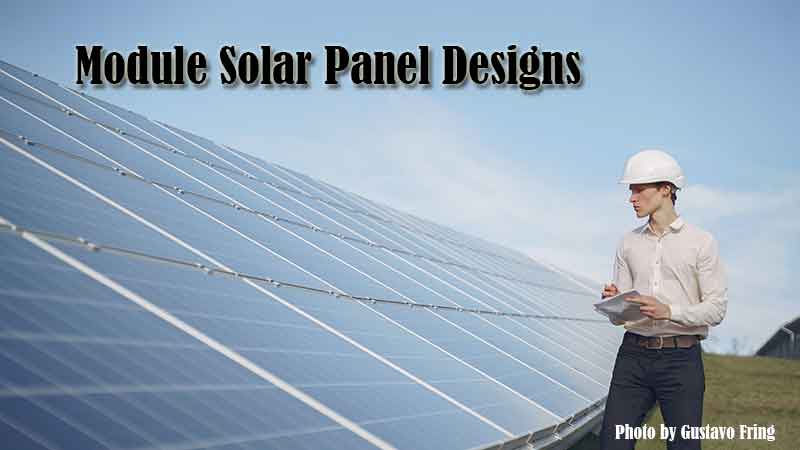Module Solar Panel Designs – Residential Solar Power -The module structure is designed to protect solar cells from the environment. It consists of a number of layers to protect the circuit of solar PV cells and to make the module easy to install. The materials used in these layers determine the cost and durability of the modules.
Module Solar Panel Designs
Solar Energy Systems Made of Component Parts
Module Solar Panel Designs – The solar cells themselves and their circuits are totally wrapped in plastic. A front layer of tempered glass, covering the solar cells, provides high transparency and low absorption. It is also tempered for strength in order to reduce the effects of falling trees or hail. The multi-layered back sheet protects the plastic and cells from abrasions and prevents moisture from getting into the module.
An edge seal is applied to protect the edges of the glass from the infiltration of dirt, water, or other non-friendly substances. The metal frame is secured around the entire glass laminate. The metal frame gives rigidity and strength to the module and allows the modules to be attached to a mounting system. Common Solar Module Design Types
There are three basic module solar designs. The first is the standard frame module that you may have experienced in the past. This design approach has been used for 30 years and usually involves an aluminum frame that allows the modules to be mounted onto a rail structure of some kind that is then directly attached to the roof. The modules are positioned above the roof surface, providing space for air to flow under the module, which helps cool the system and makes it work more efficiently.
At the same time, rainwater, leaves, twigs, and other debris can also flow under the solar panels. The rail structure is attached to the roof by means of posts that are secured into the roof rafters with long lag screws. This method is appropriate for most kinds of roofs, including ceramic tile, wood shingles, and asphalt. The roof is sealed tightly after the posts are installed to prevent any chance of leaks.
Modified Metal Frame for a Ground Mount Module Design
Module Solar Panel Designs – This modular design can also be mounted to a ground-based frame structure. Such a structure can be built on any stable terrain, can be made of metal or wood, and can hold the modules at any tilt angle or azimuth orientation (note: see previous articles related to sun angles). The ground mount can also be a pole structure to cut down on foundation work for your home. It can be stationary (i.e. not have a small motor to constantly orientate the solar panel with the sun as it tracks across the sky) or it can use a small motor to track the sun throughout the day and year.
Residential Roof Integrated Solar Energy Modules
The second type of module design is one that allows the module to be integrated into residential roofing materials. Systems connecting directly to the roofing materials (i.e. replacing shingles or laying flat to the roofing boards) are called integrated solar modules. The module frame design is modified so that it has the same profile as neighboring flat concrete tiles. The modules are not mounted to a rail structure but are attached directly to the roof surface. This low profile mount allows the module to blend into the look of the roof and avoid the retrofit appearance of standard mounted solar energy modules.
The emergence of this more attractive roof-integrated product has encouraged many production home builders to incorporate solar systems into their projects. This type blends in with the roofing materials and is attached directly to the roof surface.
-
Original price was: $599.99.$569.00Current price is: $569.00. Buy Now
Types of Integrated Solar PV Panels
One is the monocrystalline ridged frame design offered by some existing manufacturers. These PV panels are becoming more efficient and they blend well into the roofing structure. These solar cells use the same crystalline silicon technology as standard modules today. This setup has more mounting frames with fewer solar cells connected in series. This can result in a solar system that is a little more expensive. Because the roof integrated systems mount directly to the roof, they do not have the airflow of standard modules therefore the solar cell temperature gets higher, limiting their efficiency.
The other integrated solar cell product offered, by UNISOLAR, is a flexible amorphous technology. This type of solar panel is referred to as a thin film, sheet solar, or nano-solar. It is made to blend in with an asphalt shingle roof. It is somewhat less efficient, tends to degrade more quickly, and may have a shorter workable live spam. The manufacturer claims that this module is better in high-shade situations.
Solar Energy Options Hitting Roofs Everywhere
It is encouraging to see new solar energy systems hitting the market with enhanced technology, better integration options, and less complexity. It will take time to work out the bugs with these cutting-edge products. With new technology, we think comes (hopefully) a lower cost of ownership. This should enhance the use of home solar energy systems worldwide. It will be innovative financing options that allow homeowners to use the technology that will cause explosive growth.
New solar energy technologies are on the march. Exciting investments and technology proof of concepts are everywhere. It is hard to refute the good, faithful, and well-established silicon-based solar cells. These systems have a life span of 30 years and have been in active use for decades. The only deterrent, until now, has been the high price of the systems. With the option to rent the entire solar energy system including the ongoing maintenance of the system for up to 25 years, the choices homeowners now have related to renewable energy adoption in their homes are very exciting.



















[…] Module Solar Panel Designs […]
[…] Module Solar Panel Designs […]